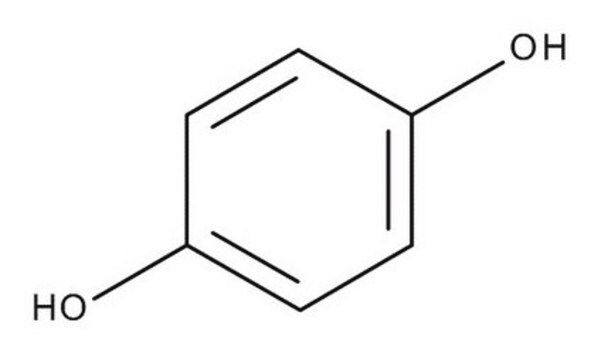Wichtige Dokumente
H3660
Hydrochinon
meets USP testing specifications
Synonym(e):
1,4-Dihydroxy-benzol, p-Dioxybenzol
About This Item
Empfohlene Produkte
Agentur
USP/NF
meets USP testing specifications
Qualitätsniveau
Dampfdichte
3.81 (vs air)
Dampfdruck
1 mmHg ( 132 °C)
Assay
99.0-100.5% anhydrous basis
Selbstzündungstemp.
930 °F
bp
285 °C (lit.)
mp (Schmelzpunkt)
172-175 °C (lit.)
Eignung
suitable for pesticide residue analysis
Anwendung(en)
pharmaceutical (small molecule)
SMILES String
Oc1ccc(O)cc1
InChI
1S/C6H6O2/c7-5-1-2-6(8)4-3-5/h1-4,7-8H
InChIKey
QIGBRXMKCJKVMJ-UHFFFAOYSA-N
Suchen Sie nach ähnlichen Produkten? Aufrufen Leitfaden zum Produktvergleich
Signalwort
Danger
Gefahreneinstufungen
Acute Tox. 4 Oral - Aquatic Acute 1 - Aquatic Chronic 1 - Carc. 2 - Eye Dam. 1 - Muta. 2 - Skin Sens. 1B
Lagerklassenschlüssel
11 - Combustible Solids
WGK
WGK 3
Flammpunkt (°F)
329.0 °F - closed cup
Flammpunkt (°C)
165 °C - closed cup
Persönliche Schutzausrüstung
Eyeshields, Faceshields, Gloves, type P3 (EN 143) respirator cartridges
Hier finden Sie alle aktuellen Versionen:
Besitzen Sie dieses Produkt bereits?
In der Dokumentenbibliothek finden Sie die Dokumentation zu den Produkten, die Sie kürzlich erworben haben.
Kunden haben sich ebenfalls angesehen
Unser Team von Wissenschaftlern verfügt über Erfahrung in allen Forschungsbereichen einschließlich Life Science, Materialwissenschaften, chemischer Synthese, Chromatographie, Analytik und vielen mehr..
Setzen Sie sich mit dem technischen Dienst in Verbindung.













